By
Archive Carlos Gardel, Alfredo Echaniz tells us its story

ess than two years ago the most important collection of objects and documents that belonged to Carlos Gardel and his mother Berthe Gardés were publicly shown. Previously they had been treasured by their heirs.
It was presented in February 2009 in a brief exhibition at the Hotel Grand Boulevard of Buenos Aires. That exhibition had a two-fold purpose: on one side, to pay homage to the man who, besides being one of the most important figures of popular art in the twentieth century, was founder of a good portion of the River Plate culture and of its peculiar way of expressing emotions. On the other side, we think that to thank and pay homage to those who have looked after all this material so that it would be in perfect condition up to these days is an act of justice.
 Alfredo Echaniz was the one responsible for the idea of making people know the Zorzal’s legacy. He was the curator of the exhibition, the one who selected the material and made it possible. Since then the idea of writing a book that would inform, at least partially, about the material that belongs to the Gardel’s legacy sprang up.
Alfredo Echaniz was the one responsible for the idea of making people know the Zorzal’s legacy. He was the curator of the exhibition, the one who selected the material and made it possible. Since then the idea of writing a book that would inform, at least partially, about the material that belongs to the Gardel’s legacy sprang up.
How the Carlos Gardel’s inheritance came to you?
My wife, Nuria Cortada de Fortuny and her sister Maria Inés are the heirs. In this story there are two figures that are very important: Mrs. Adela Blasco who is the one that makes possible the connection among all the people involved, and his husband Armando Defino who is, undoubtedly, the main character.
Adela Blasco and the grandfather of my wife, Mr. Ramón de Fortuny, were very close friends. For different reasons they emigrated to America from their Catalonian home town and, finally, they met in Buenos Aires where, both already married, started a friendship that would last for all their lifetime. The Definos, unable to have children, will give all their loving to the Ramón de Fortuny’s daughters.
In 1932 Armando was working for Gardel as his administrator. Thereafter he will be his executor. When Gardel died the Definos moved with Berthe to the now mythical house on 735 Jean Jaurés Street, the only Carlos’s home.
In 1943 Berthe Gardés died and, when in 1944 the Definos moved to 222 Saavedra Street, many of the pieces of furniture and belongings of the house of Doña Berthe were taken to a country estate in Río Ceballos (province of Córdoba) owned by Ramón de Fortuny. By that time his daughter Nuria had married to Dr. Javier Cortada.
In 1952 Armando Defino had a serious heart attack and as he was unable to work they moved with the couple Cortada-de Fortuny to the apartment of the latter located on the corner of San Juan and Boedo. Soon later both families bought and shared a wider house on Galileo Street. In 1958 Armando Defino passed away.
Adela Blasco, Defino’s widow, died in 1984 in a country house owned by María Ana Inés, one of the daughters of the Cortada-de Fortuny couple.
In sum, by holographic will Gardel appointed his mother Berthe Gardés as his only and universal heir. Berthe, also by holographic will, appointed Armando Defino as her only heir. Armando did the same as for his wife Adela Blasco and the latter would draw up her will appointing her friend and almost foster daughter Nuria de Fortuny.
In 2004 the real estate of Río Ceballos in which Carlos and Berthe Gardés belongings were kept was sold. In the moving they found, besides the furniture, a suitcase full of documents belonging to Gardel: all the letters between Carlos and Armando Defino, the birth certificate of Carlos Gardel requested to the municipality of Toulouse by his mother, death certificates, personal documents, telegrams, letters by third parties to Carlos and Armando, checks, photos, records, etc.
It is worthwhile to say that the children of the Cortadas did not know the existence of that suitcase, as well as most of the other belongings, because of their young age when the Definos moved from Jean Jaurés to Río Ceballos (some of them had not yet been born).
Finally, in 2008, at age 93, Nuria de Fortuny de Cortada died. After a thorough work, that can be regarded as a familiar archeology, many valuable objects belonging to Berthe and Carlos Gardel were found in her domicile.
How did the idea of writing the book appear?
When I knew of the existence of the collection I began to study Gardel’s life. To be honest, before that time I knew almost nothing about him except that his singing was highly regarded day after day. I devoted myself almost exclusively to study, classify and sort the material found. The knowledge I was acquiring helped me in being accurate and to polish such classification. By the early 2008 I thought I was ready to make this legacy be known. Due to all this research I succeeded in making an exhibition for the first and only time in 2009, thanks to the generosity of Mr. González Mogo who allowed us to use the facilities of the Grand Boulevard Hotel.
Among the many visitors in that exhibition I came to know Mr. Enrique Espina Rawson, president of the Centro de Estudios Gardelianos. He was so interested in it that he suggested me to write a book.
The book suggested by Espina Rawson had 200 pages, in only one color (black), with transcriptions of the letters and texts written by him about the former ones.
As graphic designer, I dared to tell Espina Rawson about the advantage of scanning the letters and printing their images in full color, instead of publishing their transcriptions. I showed him the chromatic richness contained in the letters with their different papers and ink shades, the warmth that emerged from a hand-written letter (Gardel’s was incredibly beautiful), the graphic subtlety treasured in a telegram with its seals... all these were reasons for a four-color printing.

It was obvious that the backbone of the work had to be the epistolary relationship between Gardel and his secretary and friend Armando Defino.
At the beginning, together with Mr. Espina Rawson, we began a tedious work of subject classification of all the material. When we finished this stage the amount of material and subjects was so big that we would need two or maybe even three books like this one. Everything was still very confusing and was a long way from the clear and didactic book I had planned to write.
Since then I devoted myself to sort, classify and organize the selected material. It turned out very difficult for me to decide what I had to include and what to discard. After a lot of work I managed to include everything in 10 chapters, plus an appendix (with photographs of the furniture and jewels of the collection).
After I determined what to write in the chapters, I had to choose the letters and the paragraphs to be included in each page, paying special attention that they appeared in chronological order. For that task I searched and chose each of the images that are contained in the book aiming that each of them would contribute either to the didactic or aesthetic sense of it.
Due to the amount of existing material, I suggested that, instead of the initial 200 pages, we would increase the number of pages to 300. But, however, the appendix and one of the chapters were not included in the final project for lack of space.
I made the design of the book cover, including on it the picture of the suitcase in which the documents were found.
Is it true that the presentation of the book was made without the book?
Yes, that’s right. The first time, at the Salón Dorado de la Legislatura, was made because the date was moved forward. They changed it from the late November to the mid- October. But then, at least, there were two excellent laser-made copies, better than the printed ones. Later there was a second presentation in December, at the Centro Cultural de la Cooperación and there we did not even have the laser-made copies.
And what was the reason for that, do you have any idea?
Of course, I know. The publishing house is to blame. Look, I’m going to tell something. I delivered the originals in the late September and the publishing house called only in the late October, not to correct texts (it was the only thing missing) but to show me an original completely changed. They had altered the format, changed the typographic font, slanted all the photos as if they were for a teenager album, with little shades and all that. They had omitted photos, reduced the size of others because they were “pixelated” and were not “nice”... a mess! It was a lack of respect for me, for my profession and for the public because they think people prefer a book with nice photos instead of a didactic book with a historical nature.
Not satisfied with my refusal, they made a second attempt. In it they even condensed the pages, including the Gardel’s letters, that is to say, distorting historical documents. And all these distortions were made by the designer of the enterprise who knew nothing about Gardel. Don’t you see? Graphic Design is a part of the Communication Sciences. You design in order to communícate. And this guy designed a book while he ignored what it talks about! But, indeed, they kept the bigger size. That was the important thing. It seems that big books are better! All right, for some reason they are more expensive, aren’t they?
Something more, due to the serious differences with the publishers, among other things, as for the sale prize which I regarded too high, I decided to withdraw the books that corresponded to me and I offer them via Internet at $ 180, plus delivery expenses.
Now I understand why you told me that the book was a great difficult effort for you.
Yes, more than it was necessary.
For a final conclusion: What do you think is the greater contribution that this book has made?
Firstly, spreading material (at least, partially) that was thought it was lost. Fundamental material to reassert the French nationality of Gardel as well as his excellent relationship with his mother. Secondly, for those who know nothing about Gardel, it presents them a very clear and intimate panorama of the life of this mythical character. For this the excellent texts by Espina Rawson with the great number of details contained in the letters is a good blend.
Lastly, I would say that, in this book, the number of letters, telegrams, documents and photographs, with their different colors, spellings and textures are combined to make, mainly a graphical event with an enormous testimonial value.